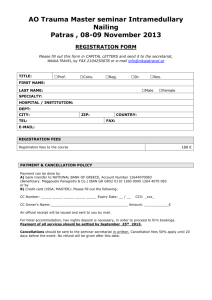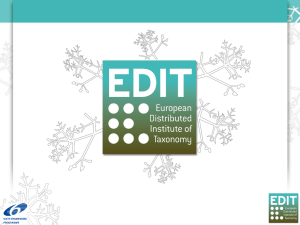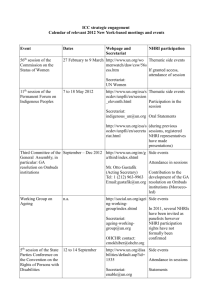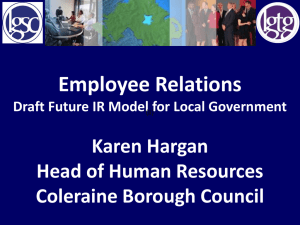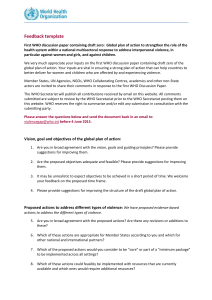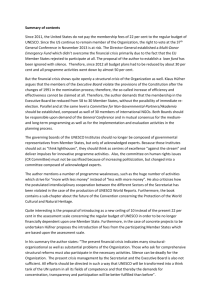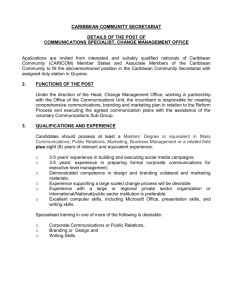Representation of Women in the United Nations Secretariat
advertisement
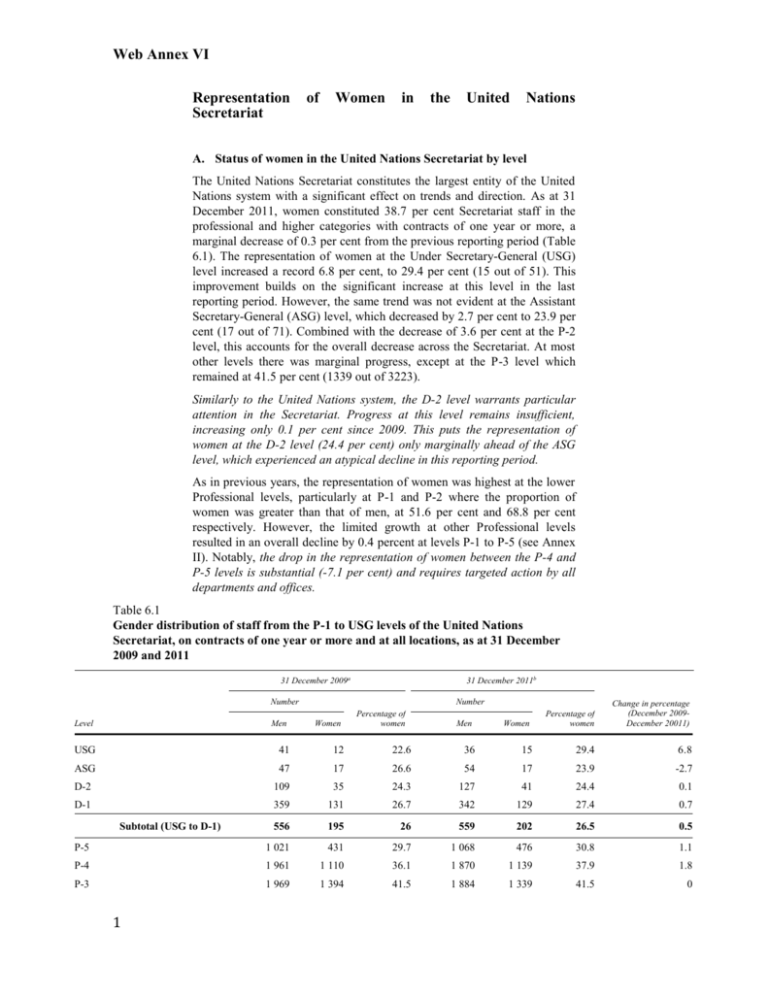
Web Annex VI Representation Secretariat of Women in the United Nations A. Status of women in the United Nations Secretariat by level The United Nations Secretariat constitutes the largest entity of the United Nations system with a significant effect on trends and direction. As at 31 December 2011, women constituted 38.7 per cent Secretariat staff in the professional and higher categories with contracts of one year or more, a marginal decrease of 0.3 per cent from the previous reporting period (Table 6.1). The representation of women at the Under Secretary-General (USG) level increased a record 6.8 per cent, to 29.4 per cent (15 out of 51). This improvement builds on the significant increase at this level in the last reporting period. However, the same trend was not evident at the Assistant Secretary-General (ASG) level, which decreased by 2.7 per cent to 23.9 per cent (17 out of 71). Combined with the decrease of 3.6 per cent at the P-2 level, this accounts for the overall decrease across the Secretariat. At most other levels there was marginal progress, except at the P-3 level which remained at 41.5 per cent (1339 out of 3223). Similarly to the United Nations system, the D-2 level warrants particular attention in the Secretariat. Progress at this level remains insufficient, increasing only 0.1 per cent since 2009. This puts the representation of women at the D-2 level (24.4 per cent) only marginally ahead of the ASG level, which experienced an atypical decline in this reporting period. As in previous years, the representation of women was highest at the lower Professional levels, particularly at P-1 and P-2 where the proportion of women was greater than that of men, at 51.6 per cent and 68.8 per cent respectively. However, the limited growth at other Professional levels resulted in an overall decline by 0.4 percent at levels P-1 to P-5 (see Annex II). Notably, the drop in the representation of women between the P-4 and P-5 levels is substantial (-7.1 per cent) and requires targeted action by all departments and offices. Table 6.1 Gender distribution of staff from the P-1 to USG levels of the United Nations Secretariat, on contracts of one year or more and at all locations, as at 31 December 2009 and 2011 31 December 2009a 31 December 2011b Number Level Men Number Women Percentage of women Men Women Percentage of women Change in percentage (December 2009December 20011) USG 41 12 22.6 36 15 29.4 6.8 ASG 47 17 26.6 54 17 23.9 -2.7 D-2 109 35 24.3 127 41 24.4 0.1 D-1 359 131 26.7 342 129 27.4 0.7 556 195 26 559 202 26.5 0.5 P-5 1 021 431 29.7 1 068 476 30.8 1.1 P-4 1 961 1 110 36.1 1 870 1 139 37.9 1.8 P-3 1 969 1 394 41.5 1 884 1 339 41.5 0 Subtotal (USG to D-1) 1 Web Annex VI 31 December 2009a 31 December 2011b Number Number Women Percentage of women Men Women Percentage of women Change in percentage (December 2009December 20011) Level Men P-2 645 795 55.2 531 567 51.6 -3.6 P-1 15 26 63.4 5 11 68.8 5.4 Subtotal (P-2 to P-5) 5 611 3 756 40.1 5 358 3 532 39.7 -0.4 Total 6 167 3 951 39 5 917 3734 38.7 -0.3 Sources: United Nations Secretariat. a See A/65/334. b Prepared on the basis of data submitted by the United Nations Secretariat. B. Trends in the representation of women in the Professional and higher categories in the United Nations Secretariat, for contracts of one year or more, as at 31 December 2000 and 31 December 2011 The Secretariat comprising the largest number of posts at several levels, including at the UG levels, significantly influences overall trends across the United Nations system (Table 6.2). Notably, the proportion of women at the USG levels rose by 20.8 per cent since 2000, the largest increase of any level and almost double the growth seen at the UG levels of the UN system. The fact that 6.8 percentage points of this growth occurred since the last reporting period suggests that political will and focus consistently improve results, and that maintaining this momentum could lead to parity at all levels. As noted in the last report, however, gains at the highest levels do not necessarily encourage change at lower levels, demonstrated by the decline in the proportion of women at the D-1 and P-5 levels (-2.9 and -0.2 per cent respectively). Indeed, the overall increase between 2000 and 2011 was only 3.3 percent for the P-1 to USG levels, and only the USG, ASG and P-1 levels have an average annual growth greater than 1 per cent. This highlights the need for targeted action at each level of the Secretariat. Table 6.2 Percentage change in the representation of women from the P-1 to USG levels of the United Nations Secretariat, on contracts of one year or more and at all locations, as at 31 December 2000 and 2011 31 December 2000a Number Level 31 December 2011b Percentage of women Men Women USGa 32 3 ASGa 30 4 D-2 89 20 18.4 D-1 205 89 30.3 356 116 543 244 Subtotal (USG to D-1) P-5 2 Number Percentage of women Change in percentage (December 2000December 2011) Average Annual Change in Percentage Points 2000-2011) Men Women 8.6 36 15 29.4 20.8 1.9 11.8 54 17 23.9 12.1 1.1 127 41 24.4 6.0 0.5 342 129 27.4 -2.9 -0.3 24.5 559 202 26.5 2.0 0.2 31 1068 476 30.8 -0.2 0.0 Web Annex VI P-4 1 075 500 31.8 1870 1139 37.9 6.1 0.6 P-3 937 613 39.6 1884 1339 41.5 1.9 0.2 P-2 331 305 48 531 567 51.6 3.6 0.3 P-1 7 7 50 5 11 68.8 18.8 1.7 Subtotal (P-2 to P-5) 2 893 1 669 37.1 5358 3532 39.7 2.6 0.2 Total 3 249 1 785 35.4 5 917 3 734 38.7 3.3 0.3 Sources: United Nations Secretariat. a See A/65/334. b Prepared on the basis of data submitted by the United Nations Secretariat. C. Projections on attainment of parity at the P-1 to USG levels of the United Nations Secretariat Data on the current average annual increment for each level of the Secretariat can be used to calculate the number of years it will take to reach parity and the year at which parity will be attained if this rate of growth is sustained. Table 6.3 shows that parity is unlikely to be achieved at the P-3 and ASG levels at the current rate of growth, which is particularly disconcerting given that the P-3 level constitutes the largest pool from which to populate the higher levels. It is also of serious concern that parity will not be achieved for 32 years at the P-5 level, which directly impacts the proportion of women available for promotion to the director levels, where parity remains a distant goal. Table 6.3 Number of years required to achieve parity at each level of the United Nations Secretariat, based on the current average annual increment Year at which gender parity will be reached at current average annual increment P1 P2 P3 P4 P5 D1 D2 ASG USG UN Secretariat Total At December 2009 – December 2011 average annual increment Reached Reached Never 2025 2044 2080 2523 Never 2016 Never Total number of years to reach parity Reached Reached Never 13 32 68 511 Never 4 Never Table 6.4 shows the year at which parity will be reached if the proportion of women increases by 2 per cent each year, and the annual growth rate required to achieve parity by 2012. This shows that by increasing the annual growth rate to just 2 per cent, parity can be achieved at all levels of the Secretariat. It also demonstrates that increases of between 2.2 and 6.5 per cent are required to achieve parity by 2012. Given the small numbers of staff at some levels of the Secretariat this should be a feasible goal, as demonstrated by recent progress at the USG levels. Table 6.4 Year at which parity will be achieved based on two per cent annual increase, and required average annual increase to achieve parity by 2012 P1 Reached 3 Year at which gender parity will be reached at 2% annual increase P2 P3 P4 P5 D1 D2 ASG USG Total Reached 2017 2015 2017 2021 2022 2024 2024 2021 Web Annex VI Required average annual increase to achieve 50% gender balance by 2012 (percentage points) P1 P2 P3 P4 P5 D1 D2 ASG USG Total Reached Reached 2.2 3.0 4.8 5.7 6.4 6.5 4.8 2.8 D. Policies and Practices of the United Nations Secretariat The Secretariat employs approximately 32.5 per cent1 of all Professional and higher level staff, and its policies shape and inform the practices of the United Nations system as a whole, with a large number of entities explicitly either following or basing their policies and practices on those of the Secretariat. The Secretary-General has also taken concerted action within the Secretariat to improve the representation of women in senior positions, almost doubling the number of women at the UG levels since 2007. The Secretary-General’s Policy Committee In 2011 the highest level Committee on policy, chaired by the SecretaryGeneral2, reviewed the status of women in the secretariat and decided3 on specific actions for Heads of Departments/Offices/Missions to accelerate progress towards the goal of gender parity. These included the requirement to update administrative instruction ST/AI/1999/9, “Special Measures for the Achievement of Gender Equality”, to ensure its effective implementation; the promulgation of an updated gender balance strategy and action plan, bearing in mind issues such as Flexible Work Arrangements (FWA); and the convening of a task force to study the situation and needs of pregnant women in difficult duty stations. The Secretary-General reaffirmed his commitment to the advancement of women4, reminding all Heads of Departments, Offices and Missions, of their responsibility to ensure meaningful progress towards gender parity and pay particular attention to P-4 to D-2 levels where they are required to normally include at least one female candidate in shortlists for Central Review Bodies (ST/AI/2010/3). Furthermore, communications have reiterated the importance of a workplace characterized by a culture of “respect for all” with a zero tolerance policy for abuse, harassment and sexual harassment, as well as the implementation of FWAs. Finally, emphasis was placed on the Departmental Focal Points for Women (FPW) and their ability to access information as deemed necessary in regards to the measurement of the percentage of women. Change Management Committee The Steering Committee on the Implementation of Change Management Measures was established at the request of the Secretary-General to manage the process of renewal in the Secretariat. In 2010, the Change Management Steering Committee endorsed the Gender Balance Strategy and Action Plan for the UN Secretariat prepared by the FPW in consultation with the Office of Human Resources. The Steering Committee was effectively replaced by the Secretary-General's Change Management Team in 2011, and 1 Based on data for all Professional and higher level staff at headquarters and non-headquarters Secretariat locations, on contracts of 1 year or more, as at 31 December 2011. This is a total of staff out of in the United Nations system. 2 Secretary-General's Policy Committee is the highest decision-making body within the U.N. Secretariat. 3 Decision no. 2011/19 – The Status of Women in the Secretariat. 4 Letter of 23 December 2011 4 Web Annex VI delivered The Change Plan in December of 2011 to foster a modern, engaged and efficient Secretariat that is transparent and accountable in its work. The Team agreed to establish a matrix to identify, track and monitor progress with respect also to the gender dimension of the relevant initiatives of The Change Plan. Implementation is underway, led by the Change Implementation Team and the Change Management Focal Point Network, of which UNW is part. Office of Human Resources Management (OHRM) outreach The OHRM has intensified its outreach efforts including the establishment of an outreach unit to broaden the scope of outreach, introducing use of social media, revamping a jobs website, producing specific promotional materials, and showcasing recruitment videos at the World Cup in South Africa and the Shanghai Expo in China.5 Departments of Peacekeeping Operations (DPKO) and Field Support (DFS) The DPKO is investing in several organizational change initiatives as part of its commitment to gender balance, especially for the senior decision making levels and to creating a gender-friendly work environment. To address these issues, in August 2011, the DPKO/DFS Senior Management Team established a Respect for Diversity SWAT Team chaired by the Director, Field Personnel Division and including senior staff members from missions and headquarters. The objectives of the team are to: (a) review each step in the outreach, selection, recruitment and deployment chain to maximize opportunities for identifying and attracting qualified international and national women; (b) examine the possibility of bias in performance appraisals, and to propose remedial measures such as bias awareness training for managers; (c) propose measures to improve the welfare of staff, particularly women serving in missions, and work with the Positive Work Environment Task Force to advance the efficient use of FWAs at headquarters; (d) suggest the necessary metrics to track situations addressed by the SWAT team; (e) measure progress towards improved gender diversity in the field and at headquarters, in all sectors, levels and missions. Exit interviews with separating female staff revealed that work-life imbalance, limited career prospects, recruitment and appraisal processes, and unfavourable contract terms reduced the Departments’ ability to retain qualified women. Technological advances, greater workforce diversity, and the increased complexity of organizations’ missions, are some of the factors driving the shift away from traditional management styles that tend to favor men. This macro-level shift may lead to more women moving into peacekeeping leadership positions, if it can be capitalized upon. Senior Managers’ Compacts and Human Resources Management Scorecards Senior Managers’ Compacts in the United Nations Secretariat are co-signed by the Secretary-General and reviewed annually by the Management Performance Board for performance against established targets. In areas of 5 http:careers.un org. 5 Web Annex VI weakness, each senior manager is then asked to submit an action plan to address them. The 2011 Manager’s Compacts included the performance measure: “Human resources are managed in alignment with GA principles, in compliance with the Organization’s rules, regulations and policies”. Two of the six related indicators, found in the OHRM Scorecards and co-signed by the ASG of OHRM, relate to gender parity and contain two targets: attainment of gender parity itself, or a 20 percent decrease in the gap between parity and the current representation of women. The gender related indicators are: Percentage of female staff in all categories of posts (excluding USG and ASG but including GS levels) – 17 departments applied the target of gender parity, while 13 had the target of closing the gap towards gender parity by 20 per cent. Twenty-three departments met their target; seven did not. Percentage of female staff in P-5, D-1 and D-2 posts - Only two (of 30) departments applied the target of gender parity (CAAC, PBSO). Ten departments reached their targets; 20 did not. These ten departments also achieved their target with respect to the first indicator, suggesting an overall commitment to gender balance from senior staff in these departments. Staff selection in the Secretariat The previous staff selection system6 stated that “If the head of a department/office who has not met the gender targets set out in the departmental action plan proposes to select a male candidate where an equally qualified female candidate exists, the proposed selection decision must be justified to, and approved by, OHRM”. However, this stipulation is not included in the current staff selection system,7 which delegates the decision to the head of the department/office “taking into account the Organization’s human resources objectives and targets as reflected in the departmental human resources plan, especially with regard to geography and gender.” Consequently, there is a need to ensure that department heads are accountable for gender targets and that such targets continue to shape their staff selection processes. It is noteworthy, therefore, that female representation was included in the 2011 Senior Managers Compact. The Senior Review Group (SRG) maintains responsibility for appointments at the D-2 level in the United Nations Secretariat. Previously,8 the Special Advisor on Gender Issues and the Advancement of Women 9 served as an ex officio adviser for gender issues in the Group, ensuring that a gender balance perspective informed the selection process of the SRG.10 Further, the two stipulations in the previous bulletin that a) submissions to the SRG from the head of department/office should include statistics on staff at the D-1 and D-2 levels including information on gender,11 and b) that the 6 ST/AI/2006/3 of 15 November 2006 paragraph 9.2. ST/AI/2010/3 of 21 April 2010 Section 1 (x). 8 ST/SGB/2009/2. 9 This position no longer exists. The responsibilities have been transferred to UN Women. 10 Conversely, the Central Review Bodies continue to have mandated participation of gender focal points, though this responsibility has transferred from an OSAGI representative to a departmental focal point in headquarters locations (see ST/SGB/2002/6 of 23 April 2002 para 2.6, and ST/SGB/2011/7 of 29 Sept 2011). 11 ST/SGB/2009/2 para 4.2. 7 6 Web Annex VI shortlist normally include at least 1 female candidate,12 have also been abolished, signaling a setback. Flexible working arrangements awareness and outreach strategy A comprehensive three-year strategy (2012 to 2014) for the strengthening of FWA was developed in order to integrate advocacy, garner support for implementation, track FWA usage and determine policy revisions. A new FWA iSeek site “Flexwork”13 was launched, a network of FWA departmental focal points established, and promotional graphic materials created. Furthermore, a baseline of FWA usage during 2011 was captured through the OHRM Scorecard. The analysis of the survey results are currently being finalized with a proposed draft due in August 2012. Finally, a six-month pilot for expanded FWA options was rolled out in November 2011 in three Departments/Offices. Gender balance strategy and action plan The gender balance strategy and action plan for the United Nations Secretariat is currently being reviewed by OHRM.14 Network of Departmental Focal Points A network of approximately 60 departmental focal points (DFPs) and alternates in the Secretariat coordinated by the FPW facilitates the formulation, implementation and monitoring of gender-relevant policy, the sharing of good practices in the Secretariat and, where relevant, the wider United Nations system. The mandate of the DFPs is to support the head of the department, office or regional commission in fulfilling his or her responsibilities for the achievement of gender equality.15 A 2011 survey of the DFPs and alternates found that 48 per cent reported that management had taken no measures to increase the awareness of their function in their department or entity. On a more positive note, 52 per cent reported an increase in gender sensitivity within the staff selection processes in their departments Recommendations from survey respondents include the appointment of more alternates to cope with heavy workloads, and strengthening the network through the inclusion of other United Nations system entities. 12 Ibid para 4.1. United Nations staff members can access the website at http://iseek.un.org/webpgdept2105_1.asp?dept=2105. 14 The gender balance strategy and action plan for the United Nations Secretariat was originally to be promulgated by DM/OHRM in the prior reporting period as required by the Policy Committee decision, but was delayed due to staffing constraints and competing demands on time. 15 Source: ST/SGB/2008/12 paragraph 1.2. 13 7 Web Annex VI Table 6.5 Gender distribution of staff from the P-1 to USG levels of the United Nations Secretariat by department, on contracts of one year or more and at all locations, as at 31 December 2011 USG ASG D-2 D-1 P-5 P-4 P-3 P1 P-2 Department/Office M F M F M F M F CTED 0 0 1 DESA 3 0 3 0 1 1 10 DFS 1 1 DGACM 1 0 1 0 4 1 0 3 DM/ACABQ 0 0 0 0 DM/CMP DM/OCSS 0 0 1 0 0 1 DM/OHRM 0 0 DM/OPPBA 0 DM/OUSG 1 DM/SECCOM DPA 0 1 0 5 4 7 4 1 1 7 24 9 53 29 49 48 61 30 0 6 2 16 11 41 25 51 39 1 12 3 78 46 113 109 99 107 0 1 1 0 0 2 1 1 0 1 0 1 0 0 0 2 1 2 1 1 0 1 0 3 0 8 3 17 14 16 0 1 1 2 1 2 14 7 12 24 0 0 0 2 0 6 3 10 11 21 0 0 0 1 3 3 7 13 8 18 0 0 0 0 0 0 0 0 1 0 0 1 4 0 2 0 8 1 8 5 29 12 23 25 DPI 1 0 0 0 3 1 4 10 19 11 34 29 DPKO 1 1 3 0 2 4 12 2 26 9 93 DSS 1 0 0 1 1 0 4 0 11 2 20 ECA 1 0 0 0 0 0 12 6 58 13 ECE 1 0 0 0 1 0 3 6 20 ECLAC 0 1 0 0 1 0 11 2 20 EOSG 2 1 4 1 4 0 5 1 7 ESCAP 0 1 0 0 1 0 8 5 23 ESCWA 0 1 0 0 1 0 7 2 13 0 0 0 0 0 1 0 0 0 1 0 0 1 1 11 3 30 6 43 2 91 26 266 71 615 243 765 357 Ethics Office FM/DFS 8 M F M F M F M Subtotal M Total Percentage Women F M F F 2 2 0 0 18 11 29 37.9 99 108 2 6 304 238 542 43.9 2 6 0 0 122 84 206 40.8 10 17 0 0 317 283 600 47.2 0 0 0 0 2 5 7 71.4 1 0 1 0 0 7 4 11 36.4 9 3 6 0 0 49 32 81 39.5 13 18 7 7 0 0 48 61 109 56.0 29 20 21 6 4 0 0 65 68 133 51.1 20 8 10 0 2 0 0 44 50 94 53.2 0 0 0 0 0 0 1 1 2 50.0 18 18 8 13 0 0 100 74 174 42.5 32 39 14 22 0 0 107 112 219 51.1 30 31 22 6 7 0 0 174 75 249 30.1 14 22 6 4 3 0 0 63 26 89 29.2 41 27 50 21 13 8 0 0 175 75 250 30.0 6 24 10 15 17 9 8 0 1 73 48 121 39.7 5 43 17 25 23 18 24 1 0 119 72 191 37.7 3 8 10 1 2 0 2 0 0 31 20 51 39.2 9 28 13 28 22 11 10 0 0 99 60 159 37.7 10 19 10 9 9 6 8 0 0 55 40 95 42.1 1 0 0 0 2 3 5 60.0 172 116 0 0 1993 824 2817 29.3 Web Annex VI ICT 0 0 1 0 1 0 3 0 9 4 15 6 20 9 3 1 0 0 52 20 72 27.8 Interorg. 0 0 0 0 0 1 0 0 1 1 1 2 1 2 1 0 0 0 4 6 10 60.0 OAJ 0 0 0 0 4 2 0 1 2 1 1 3 2 3 0 3 0 0 9 13 22 59.1 OCHA 0 1 0 2 2 1 8 4 41 22 102 75 158 102 17 25 0 0 328 232 560 41.4 ODA 1 0 0 0 1 1 2 1 10 3 9 1 7 4 1 4 0 0 31 14 45 31.1 OHCHR 0 1 1 1 2 1 6 2 31 21 49 59 69 98 12 24 0 0 170 207 377 54.9 OHRLLS 1 0 0 0 0 0 1 0 1 1 3 1 1 1 0 0 0 0 7 3 10 30.0 OIOS 0 1 0 0 1 2 4 2 15 9 51 22 21 28 4 8 0 0 96 72 168 42.9 OLA 0 1 2 1 3 1 6 4 10 10 12 10 7 12 7 2 0 0 47 41 88 46.6 Ombudsman 0 0 1 0 0 0 0 1 1 3 1 0 0 2 0 0 0 0 3 6 9 66.7 OSAA 0 0 0 0 1 0 1 1 1 0 0 3 2 1 0 0 0 0 5 5 10 50.0 OSRSG/CAAC 0 1 0 0 0 0 0 0 0 1 1 0 0 1 0 0 0 0 1 3 4 75.0 ROL 0 0 0 0 0 0 0 0 1 0 0 0 0 0 0 1 0 0 1 1 2 50.0 UNCC 0 0 0 0 1 0 0 0 1 2 2 0 0 0 0 0 0 0 4 2 6 33.3 UNCTAD 1 0 1 0 5 1 13 8 34 14 46 18 61 33 21 12 1 0 183 86 269 32.0 UNEP 1 0 1 2 6 5 35 9 81 30 112 77 84 82 27 58 1 2 348 265 613 43.2 UNFIP 0 0 0 0 0 0 2 0 1 2 0 1 1 0 0 1 0 0 4 4 8 50.0 UN-Habitat 1 0 0 1 1 1 16 1 37 11 35 25 30 30 10 16 0 0 130 85 215 39.5 UNODC 1 0 0 0 3 0 8 1 26 21 67 35 51 54 10 15 0 1 166 127 293 43.3 UNOG 1 0 0 0 3 0 7 3 44 30 74 68 63 69 15 13 0 0 207 183 390 46.9 UNON 0 1 0 0 2 1 3 0 12 4 14 9 20 15 6 5 0 1 57 36 93 38.7 UNOAU 0 0 0 0 1 0 0 0 3 0 12 4 2 1 0 0 0 0 18 5 23 21.7 UNOS 1 0 0 0 0 0 0 0 0 0 1 0 0 0 0 0 0 0 2 0 2 0.0 UNOV 0 0 0 0 1 1 5 0 14 12 33 16 17 18 6 5 0 0 76 52 128 40.6 Total 36 15 54 17 127 41 342 129 1068 476 1870 1139 1884 1339 531 567 5 11 5917 3734 9651 38.7 Total Percentage 9 29.4 23.9 24.4 27.4 30.8 37.9 41.5 51.6 68.8 38.7
